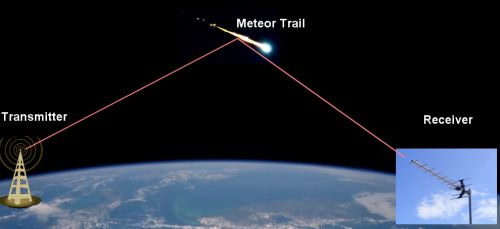(from: Live meteor echoes at LIVEMETEORS.com)
Listen Live to meteors! [Link]
This PING's for you! [Link]

In order to listen to meteor echoes, you need a powerful transmitter in VHF band (ideally a tower broadcasting analog TV on a channels 2-5) located not too close but not too far either from you, a TV antenna, a VHF receiver... and patience.
The meteor detector at LIVEMETEORS.com is located in DC Metropolitan area and is currently pointing the Yagi antenna at a TV tower in Canada broadcasting on channel 2 analog TV, around 55.24 MHz, or based on availability and propagation on channel 3 analog TV, around 61.260 MHz, likely located in Timmins, ON. Receiver is RTL/SDR and software is SDR#.
Please see:
Listen Live to meteors! [Link]
This PING's for you! [Link]
(from: Live meteor echoes at LIVEMETEORS.com)
When a meteor enters the Earth's upper atmosphere it excites the air
molecules, producing a streak of light and leaving a trail of ionization
(an elongated paraboloid) behind it tens of kilometers long. This
ionized trail may persist for less than 1 second up to several minutes,
occasionally. Occurring at heights of about 85 to 105 km (50-65 miles),
this trail is capable of reflecting radio waves from transmitters
located on the ground, similar to light reflecting from a mirrored
surface. Meteor radio wave reflections are also called meteor echoes, or
pings.

In order to listen to meteor echoes, you need a powerful transmitter in VHF band (ideally a tower broadcasting analog TV on a channels 2-5) located not too close but not too far either from you, a TV antenna, a VHF receiver... and patience.
The meteor detector at LIVEMETEORS.com is located in DC Metropolitan area and is currently pointing the Yagi antenna at a TV tower in Canada broadcasting on channel 2 analog TV, around 55.24 MHz, or based on availability and propagation on channel 3 analog TV, around 61.260 MHz, likely located in Timmins, ON. Receiver is RTL/SDR and software is SDR#.
Please see:
Posted by PSRG FUN BLOG at 12-13-2017 10:00PT

